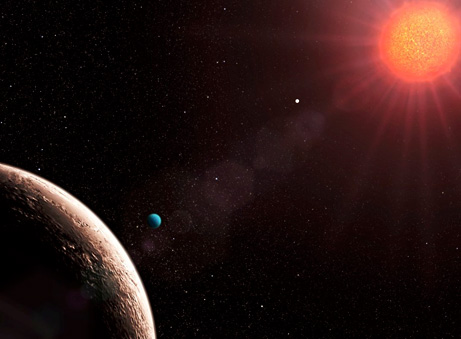 | |
| Artist's view of Gliese 581 planetary system |
A team of observers from University of California(UC) Santa Cruz and Carnegie institute of Washington have declared the finding of a potentially habitable planet in the planetary system of a red dwarf star(a small and relatively cool star) Gliese 581. Gliese 581 is a star 20.3 light years away from earth in the constellation Libra.
It has six planets 581e,b,c,g,d,f. From a decade of observations from W.M.Keck observatory in Hawali, researchers have concluded that planet Gliese 581 g is in the habitability zone of the planetary system. It is around 3 to 4 times the size of the earth and it orbits around its star in just 37 days. Planet's mass indicates that the planet is not composed of gas, but is rocky and that it has enough gravity to sustain an atmosphere.
What does potentially habitable mean?
Planetary habitability is the measure of a planet's or a natural satellite's potential to sustain life.To astronomers, a "potentially habitable" planet is one that could sustain life, not necessarily one where humans would thrive. NASA has defined the principal habitability criteria as "extended regions of liquid water, conditions favorable for the assembly of complex organic molecules, and energy sources to sustain metabolism." As life outside earth is an unknown phenomenon, A potentially habitable planet always means that it has conditions similar to that of earth. Further it means that the planet can sustain life forms like that of Earth. Possibility of newer forms of life are not contained as we do not know what other forms of life can evolve or in what circumstances.
So, how does Gliese 581 g fits into picture? As mentioned earlier, the planet is expected to be rocky and to have a definite surface which is a very important and obvious requirement. In addition, Gliese 581 g turns out to be an interesting planet, as only half of the planet faces its star all the time. If you already know that we can always see the same face of the moon, you should not be surprised by it. So, an estimation says that the hotter face of the planet may have a temperature around 343K(70 degree C) with day all the time and cooler face might have a temperature around 238K(-35 degree C) with night all the time. Steven Vogt, a professor from UC Santa Cruz says that the habitable region in the planet would be the line between these faces known as terminator. Considering these conditions and distance of the planet from its star, Researchers hope that there might be considerable amount of liquid water in some regions of the planet. Further, with an atmosphere, the planet fits rightly into the place of a potentially habitable planet.
Is this finding significant?
I must say it surely is. What this Lick-Carnegie Exoplanet Survey found shows us a wide range of possibility. Finding extraterrestrial life has always been a human interest. The finding may be followed by many other such findings. Hope we may get to know our neighbors one day... Wouldn't that be great?
References and links:
*See the original research paper by Steven S. Vogt, R. Paul Butler, Eugenio J. Rivera, Nader Haghighipour, Gregory W. Henry, Michael H. Williamson at http://lanl.arxiv.org/PS_cache/arxiv/pdf/1009/1009.5733v1.pdf
*For more information on planetary habitability, see wikipedia
*For brief information on the methodology of observation visit NASA website
No comments:
Post a Comment